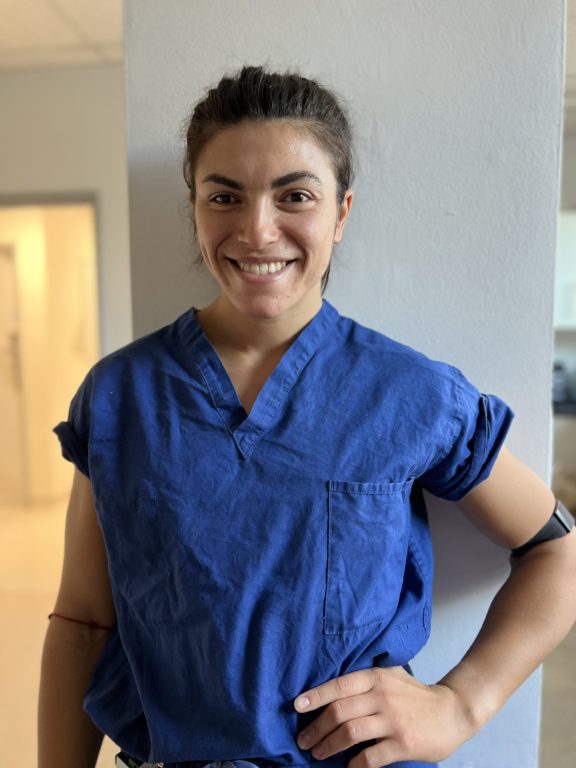It’s the end of a 13-hour shift, and Olivia Tompkins, an ICU nurse, has been on her feet for most of that time. She’s changed dressings and lines, administered medications, comforted distraught family members, and lifted and shifted bed-bound patients. Her body aches with the effort of it all.
An alarm pierces the air — her patient’s heart has stopped. Tompkins throws herself into CPR.
It’s not like in the movies, where a few gentle compressions make a miracle. Beneath Tompkins’ outstretched arms and clasped hands, ribs crack. Beads of sweat condense on her forehead as she labors.
The patient doesn’t make it. But that’s the gig — you can’t always save them, but you have to make all the hard choices anyway.
Long after the sun has set, Tompkins returns, spent, to her home in London, England. She has another hard choice to make before her day is done: collapse and escape the day with whatever brings her a slice of comfort — or train.
“I’ve seen tired — and not like you’re in a workout and you want to stop and you want to give up and you want to have a break,” the 27-year-old said. “I’ve seen people who are on the path of passing away, breathing and trying to survive.”
So she rolls her barbell and a set of plates out into her garden — and she gets even more uncomfortable.

It’s been said that CrossFit is not for everyone, but it is for anyone. Not everyone will want to put the work in, but for those who do, the results will follow.
Despite their roles as healthcare professionals, nurses suffer from an increased risk for lifestyle-related diseases; namely, obesity, hypertension, and diabetes — just like their patients.
“We’ve done CPR on them (and) got them stable … and then your colleague sits down next to you and starts eating McDonald’s,” Tompkins said.
It may seem an odd juxtaposition that those who witness firsthand the ravages of chronic disease seem to fall victim to the choices that lead to it just as often as others. But for healthcare professionals, poor diet and sedentary lifestyle outside of work is usually not the result of a lack of knowledge but rather of empty-cup syndrome. After lengthy and grueling shifts caring nonstop for others, there’s just nothing left for themselves.
“I definitely think that nurses are renowned for looking after others and not looking after themselves, and that’s really upsetting to me,” Tompkins said.
There are two types of shifts nurses typically work, Tompkins said: Long day or long night. Both are 13-hour shifts, and the stress starts before the day even begins.
“I get pre-shift anxiety, not because you’re dreading it, but because you have such a big responsibility as soon as you walk into the hospital,” she said.
Tompkins wakes up around 5:30 a.m. for her 7:45-a.m. shift. After a morning meeting, she’s assigned her patient for the day.
“As soon as you walk into that room and you’re with that patient, your patient’s life is your life,” she said.
Tompkins described the morning as a repeat process of “act and assess.” Why is the patient’s blood pressure elevated? What needs to be done about it? At some point, a doctor will come by and perform their own assessment and write a plan for the day. Often, it will involve preparing a patient for a procedure, such as a CT scan or blood draw. In the ICU, patients receive a daily X-ray at minimum.
“So this is just 10 o’clock,” Tompkins said. “And you’ve probably already started giving infusions that can be changed hourly.”
Come 11 a.m., it’s time for the first roll.
ICU patients need to be shifted into different positions at regular intervals to encourage blood flow and prevent pressure lesions, or bed sores. With patients weighing sometimes as much as 450 lb (204 kg), chests open and tethered to ventilators or ECMO machines, the roll can take anywhere from 10 minutes to more than an hour, sometimes requiring as many as seven people to execute.
Afterward, multidisciplinary teams arrive to create their own care plans for the patient: physiotherapists, speech and language therapists, dieticians, and others. Then it’s time for afternoon medications. If she’s lucky and there’s a floater free nearby, Tompkins can take a 20-minute lunch break. If not, lunch has to wait.
Afternoons and evenings present another kind of challenge: visiting hours.
“As soon as there’s another person by your bed space, that’s another person that you’re looking after,” Tompkins said.
Family members — unused to the mechanical beeps and whirs and rattled by the sight of their unconscious loved one — often become upset during visits.
“And then as soon as they are upset, you go to comfort,” Tompkins said. “Because that’s what we do.”
By evening, it’s time for another roll. After that, Tompkins will call the patient’s family — if they haven’t visited yet — to give an update. Then comes evening ward rounds, when nurses update doctors on their patients’ progress and prepare for the night-shift hand-off.
Impossible to list are the innumerable small acts of care — such as massaging a patient’s eyes to prevent blindness or moistening their lips with Vaseline — nurses carry out regularly.
“It’s emotional, it’s physical, it’s mental, and it’s nonstop,” Tompkins said.
CrossFit trains you to get comfortable with being uncomfortable. You get to experience the one-for-one reward of effort and results. This develops resilience and grit that are transferable to every aspect of life.
Tompkins has long known she wanted to pursue a career in healthcare, and while volunteering at a hospice center as a teenager, she set her sights on becoming a nurse.
She recalled speaking with a terminally ill man at the hospice center, listening for hours to stories about his life, family, and passions.
“I think you’d be a wonderful nurse,” he told her. “You’ve given me the time of day.”
It’s a service-oriented mindset Tompkins embodies today, caring for her patients in small ways beyond the medical: brushing their hair, holding their hands, or playing their favorite music.
“Your whole day is being empathetic to everything and everyone,” she said. “And that is so exhausting.”
Add in a little sleep deprivation — a common occurrence for nurses pulling long shifts and picking up extra ones on the side — and it’s easy to see why most skip the gym and pick up a pizza on their way home from work.
Tompkins’ mission is to show her peers that there’s a better way.
“I think that it helps to be a nurse and inspire other nurses that it is possible; that you can have a good quality of life and do the job that we do.”
At the highest expression of their craft, our coaches are leaders. They are not trained to say, “Look at me”; they are not there to show you how fit they are and how good they look. Their work is about service. The focus is on how fit they can make you.
Tompkins fell in love with fitness as a teenager after taking a group fitness class featuring free weights with a strong female instructor.
“She was the first woman I saw with a six-pack,” Tompkins said.
As time went on, Tompkins moved on to strength machines, and eventually, back squats and deadlifts with a barbell. In 2014, when Tompkins was around 18, a friend invited her to try CrossFit.
“There were wall balls and box jumps and pull-ups in the first workout,” she recalled. “I just remember having to scale everything, but I loved the environment; I loved the community.”
Today, Tompkins trains to compete at an elite level. But that doesn’t mean she’s left nursing behind.
“CrossFit is an important part of my life, and so is being a nurse — and both of those things together is an amazing thing to have,” she said.
In fact, CrossFit is critical to her ability to care for others.
“It fills me with energy and positive endorphins and puts me in a positive mental state,” Tompkins said. “You fill your cup up so that you can give to others.”
In addition to her platform on social media, where she aims to inspire all to prioritize their fitness, Tompkins spreads her message far and wide on the nursing floor, leading by example with healthy meals brought from home and lunch-break workouts.
Nurses should do CrossFit not only to take care of themselves, she argues, but to be better at nursing.
“That’s a real big niche that I feel is untapped,” she said, noting that her colleagues often look to her for help with patient rolls or carrying heavy equipment. And when ICU patients awaken after weeks of sedation, they need all the help they can get when it comes to learning to move again.
“The physiotherapy needed is massive and a really big part of recovery, and physios only come around for 30 minutes a day,” Tompkins continued. “They need support to (teach) them to … sit up and stand, and there’s so many times I’ve had to do that.”
An opportunity exists for nurses to not only help people survive the ordeal that put them in the ICU, but also to regain functionality.
“You can, as a nurse, instruct people how to move better,” Tompkins said.
We are not sticklers for moving well because we want to rain on your effortful parade. We are sticklers because we know you will get more out of your effort and stay in the game longer when you do it right.
There are two typical reactions to seeing life — and death — in its rawest forms, Tompkins said. For some, watching a loved one decline is a catalyst for change.
For others, “it can do a sort of opposite thing of ‘Well, we all end up in the same place, and I’m just going to enjoy what I do.’”
It’s all a matter of perspective — of ethos.
And whether you’re a nurse or not, you get to choose what yours is.
“CrossFit can really save your life,” Tompkins said. “You don’t have to be ill to take more of a grip on your own health.”
Comments on Healthcare and Self-care: How CrossFit Can Help
I too am a ICU nurse. I truly understand. I get up before my shift to go to CrossFit and it is my drug of choice. I am energized and ready for the day. I have noticed that CrossFit has helped with my mental health and my performance at work. I also can do many rounds of CPR. Continue up with the great work the patients depend on you.
Crossfit is feeding your spirit.
Healthcare and Self-care: How CrossFit Can Help
3